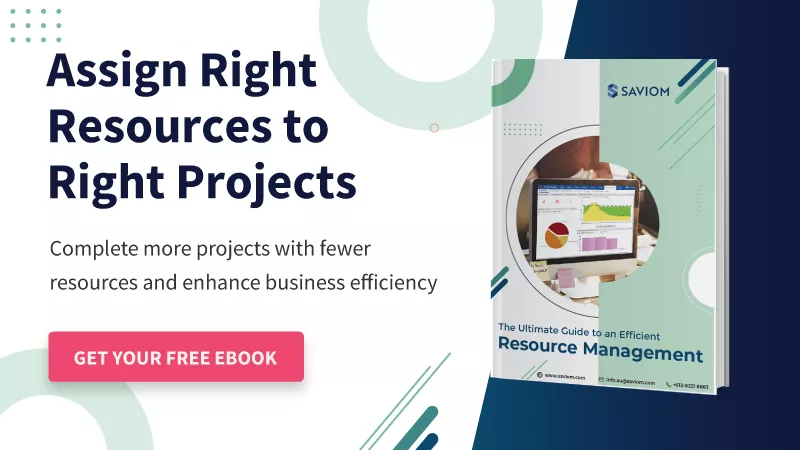The business landscape in audit and accounting firms is undergoing a paradigm shift owing to digitization, market volatility, rapidly changing tax legislation and compliance, global trade expansion of companies, and so on.
As a result, accounting firms must build an efficient and future-ready workforce to keep up with these changing trends and prosper in the hypercompetitive market.
However, building an optimized workforce while ensuring every assignment is delivered successfully is easier said than done.
Most audit and accounting businesses worldwide are dealing with issues such as talent shortage, miscommunication between sales and delivery teams, reliance on inefficient tools for consultant scheduling, and sub-optimal resource utilization, among others.
Therefore, the pertinent question is, how to address these resourcing challenges in accounting & auditing firms and optimize the workforce?
This informative article addresses and highlights various resource optimization measures within this industry. But before we get there, let’s begin with the basics-
How do auditing and accounting firm function?
Auditing and accounting are critical components of any business’s financial operations and record-keeping activities. Their duties and objectives, however, are distinct. While accounting encompasses everything, including the flow of money from the organization to the company’s management, auditing is a more specialized function.
Accounting firms’ primary functions are keeping an accurate record of financial transactions, keeping a journal of expenditures, and so on. The most fundamental accounting function is data recording and adhering to compliance requirements.
Auditing function examines a company’s operations to ensure that its financial statements and records accurately reflect its business status. It also includes assessing a company’s health and safety provisions, IT security and helps make decisions accordingly.
The firms may also offer advisory services covering a broad spectrum of areas, including advising clients on improving their business performance, rearranging their corporate structure, or dealing with risks they face, etc.
Now that we have established the auditing and accounting firms’ functions, let’s look at some of the critical roles in the industry.
Key resources in the Accounting Industry
- Chief Financial Officer (CFO) – The CFO is a C-Level Executive responsible for overseeing and managing your business’s various financial aspects. The CFO is concerned with the company’s long-term success, ROI (return on investment), resources, and direct investment.
- Accountants – The accountant in the firm is responsible for performing and overseeing the essential, day-to-day functions of the company’s accounting department. This includes accounts receivable, accounts payable, tax preparation and payment, payroll, internal accounting, and operations.
- Bookkeeper – The bookkeeper is responsible for the daily performance of the accounting department’s basic operations. This includes creating and maintaining invoices, preparing checks, processing stop payments, filing, and keeping a record of documents.
- Auditors – The primary goal of the auditors is to identify potential risk areas for a company, such as mismanagement, fraud, and other discrepancies. Companies hire these types of professionals to avoid legal and financial problems.
- Tax Executives – They do tax planning and preparation for individuals, estates, trusts, and small enterprises and research uncommon tax issues. In addition, they prepare tax returns, research tax questions, and counsel clients on tax issues.
- Consultants – They are responsible for internal and operational control procedures, budgets, analyses of projects or departments, and a variety of particular-purpose studies. They also supervise consulting assignments within client organizations.
Now that we’ve established the functions of the critical roles let’s look at the significance of resource optimization in the accounting industry.
Read More: Resource Management: A Comprehensive Handbook for Project Managers
Significance of resource optimization in Auditing and Accounting Firms
As mentioned earlier, audit and accounting firms operate in a highly competitive and volatile global market. As a result, they face some of the most pressing challenges, such as skill shortages, cost pressure due to global competition, suboptimal resource utilization, unplanned attrition, burnout issues, and so on.
Resource optimization is the ideal technique or strategy to combat these challenges effectively and efficiently. Managers can perform gap analysis by assessing current workforce capabilities and future staffing needs. Accordingly, they can take course-corrective measures and continuously match supply with the demand. This ensures optimum consultant utilization and improve business profitability.
For instance, accounting managers can adopt the resource leveling techniques for the projects with flexible timelines and adjust the start and end date according to the consultant’s availability. On the other hand, for time-sensitive projects, managers can pull in more consultants and redistribute the booked resources’ schedule.
This way, the tasks can be accomplished without deviating from the timeline. It will also improve employee morale and reduce burnout rates, resulting in higher profit margins, cash flow, and overall business efficiency.
Given the importance of optimization, let’s examine the best ways to practice these resource optimization strategies in the audit and accounting sectors.
7 strategies to optimize resources in the Audit and Accounting Industry
Resource optimization techniques are critical in the audit and accounting sector to ensure optimal staff utilization and improve business efficiency.
Here is an overview of the same –
Forecast and bridge the capacity gap of consultants in advance
Due to a lack of foresight into future audit and accounting projects, organizations often fail to identify the resource demand for consultants with their corresponding competencies and skill sets. This often translates to skill shortages leading to last-minute firefighting for competent resources, cost overruns, project delays, and compromised deliverables.
In this case, managers should proactively foresee the demand of current and pipeline projects and implement resourcing measures to bridge the capacity vs. demand gap. Managers can either undertake planned hiring or devise a training and upskilling program if there is a shortage of accountants or auditors. This way, organizations can avoid last-minute firefighting for consultants, avoid cost escalations, reduce overall risks, and maximize productivity.
Read More: How to Measure Resource Capacity and Demand
Evaluate consultant’s availability & vacation before allocation
An accounting consultancy firm often juggles various projects, especially during the peak season, such as fiscal year-end. Therefore, managing and tracking consultants’ overall availability for events such as sick leave, time off, and public holidays is crucial. Failure to do so may result in resource’s overallocation or project delays. Furthermore, if the project is handed over to a less competent resource, it results in project delays and sub-par quality of deliverables.
Therefore, tracking their availability in real-time is critical before allocating consultants to projects. This will ensure that the right consultant is allocated to the right project at the right time. Further, this reinforces the organization’s ability to deploy appropriate resources to suitable projects at the right time and cost. It ensures profitable client engagement and optimal utilization of the accounting staff.
Monitor and track audit & accounting personnel’s utilization levels periodically
In a profession where accuracy and attention to detail are essential, an under/overutilized workforce can damage the firm’s profitability if left unregulated. At times, managers overlook the utilization of the audit and accounting staff when resources are engaged in a non-billable task. As a result, this leads to a significant decrease in productive utilization, reducing overall profitability.
Tracking the team’s utilization rate periodically will reveal whether the team is over/underwhelmed with the workload. In addition, monitoring the utilization rates will help you re-plan and reassign tasks if needed. Both overutilization and underutilization can have adverse effects on the project. By defining appropriate variables to measure billable utilization and improving resource allocation, one will be better prepared for future projects.
Read More: How to Track Resource Utilization?
Cross-train audit & accounting staff to combat resource planning bottlenecks
Like any other industry, accounting & audit projects may encounter sudden unplanned absenteeism from critical resources owing to illness, resignation, vacation, or a family emergency. As a result, it can create a bottleneck, delaying subsequent dependent tasks. To address such unforeseen circumstances, it is imperative to have a skilled, competent, and adaptable workforce ready to step up when a staff member is absent.
Implementing cross-training programs will help accounting personnel comprehend the department’s broader business operations, utilize their skills in different fields of operation, and work on multi-faceted projects. This will reduce the monotony of the job and ultimately boost productivity, and foster collaboration.
Implement resource optimization techniques during seasonal fluctuations
Projects in audit and accounting firms are seasonal, with a noticeable surge in workforce demand for auditors, accountants, and tax analysts, among others, throughout the year. However, these organizations are often ill-equipped to meet these sporadic spikes. This results in an overworked and demoralized workforce and substandard deliverables, causing a loss of billable projects and clientele.
Managers can address this issue by implementing optimization techniques to manage these seasonal demands effectively. If the timeline is flexible, one can implement resource leveling to adjust the start and end dates and balance the workload of resources. If the project timeline is too rigid, additional staff can be pulled in to assist with task execution. This will reduce workload and increase profitability.
Read More: How can you Implement Workforce Optimization to Improve Productivity?
Keep your consultants updated about the latest tax laws and policies regularly
Compliance monitoring is a quality assurance test that forms the crux of an accounting firm’s functions. Therefore, through formal training, accounting and auditing firms must ensure that their consultants stay updated with the latest developments, such as new, revised, or withdrawn regulations.
With this accurate information, the audit and accounting firm can help their future clients to respond to changes strategically rather than reactively. Also, prepare their customers to improve the effectiveness of their company’s policies and procedures. As a result, the accounting system, processes, and consultant’s performance will improve significantly.
Create the right mix of permanent and contingent workforce
During the financial year-end, an accounting consultancy firm often faces high demands for accountants, tax analysts, budget analysts, etc. If your company lacks the right mix of skilled workforce, it will result in loss of business opportunities, client dissatisfaction, hamper market reputation, and reduced profitability.
To combat this, managers should first analyze the nature of the project and then create the right balance of permanent and contingent consultants. This will significantly reduce the workload of critical permanent resources. They can also leverage a competent resource with a lower charge-out rate as long as the quality of the deliverables isn’t compromised. This will help keep resourcing costs in check, ensure deadlines are met, and keep the project budget under control.
Read More: What is a Contingent Workforce and Why an Organization Needs It
Now that we’ve discussed effective ways to optimize audit and accounting firm resources, let’s look at how resource management software can help.
How can resource management software help in workforce optimization?
From the previous sections, it is evident that workforce optimization is a significant function that audit and accounting firms must implement. An advanced resource management solution can be a one-stop solution to plan, forecast, and build an optimized workforce.
The tool provides 360-degree visibility into the resource pool of audit and accounting firms and helps centralize information on a single platform.
The resource forecasting feature can identify resource demand ahead of time. This enables one to take suitable measures to bridge the demand vs. capacity gap, reducing resource shortages in the accounting and auditing firm and streamlining resource allocation.
Further, the tool provides the forecast vs. actual utilization reports and heatmaps, which give insights if a resource is being over- or underutilized. Accordingly, accounting managers can implement corrective measures and optimize utilization rates.
Moreover, using the modeling and simulation technique within the tool enable managers to arrive at the best possible outcome, and juggle resources across projects. Lastly, the tool provides real-time business intelligence reports with actionable insights to strengthen your decision-making process.
In a nutshell, resource management software can be a game-changer in optimizing the audit and accounting workforce.
Conclusion
Maintaining a large talent pool of highly skilled accounting and auditing consultants can be difficult in an industry that relies heavily on knowledge and experience. As a result, managers frequently face resource constraints, particularly in multi-project environments.
However, by combining the aforementioned resource optimization strategies with robust resource management software, auditing and accounting firms can ensure successful project delivery.
So, how do you optimize resources in your audit & accounting firm?
The Glossary
Read More: Glossary of Resource Workforce Planning, Scheduling and Management
The SAVIOM Solution
SAVIOM is the market leader in offering the most powerful and configurable solutions for managing enterprise resources efficiently and effectively. Having more than 20 years of experience, this Australian-based MNC has a global presence in over 50 countries. It is also popular with more than 100 customers and helps them achieve their business goals. SAVIOM also has products for project portfolio management, professional service automation, and workforce planning software which can be easily customized as per business requirements.












